2015-05-17 At the Copenhagen Airpower Symposium on April 17, 2015, Group Captain Paul Godfrey, OBE, Royal Air Force, focused on the transformation of the Royal Air Force. Group Captain Paul Godfrey, OBE has extensive experience of a range of combat aircraft through Harrier, F-16 and Typhoon.
As a Harrier weapons instructor, he was the first non-US national to fly the F-16 CJ operationally in the SEAD (Suppression of Enemy Air Defense) role while on exchange with the USAF and has spent the last 10 years in the Typhoon program with two flying tours including 4th/5th generation fighter training with the F-22.
After his current tour working on the Initial Operating Capability of the UK F-35B, he will become Station Commander RAF Lossiemouth, where three Typhoon squadrons are now located.
With his range of combat air experience, Godfrey is well positioned to understand the next generation capability which 5th generation aircraft can provide for the Royal Navy (RN) and RAF and as such entitled his presentation as “F-35 as a Catalyst for Change.”
It is clear that the RAF is suffering from the same fiscal challenges which translate into reduced numbers which Gary Schaub, Jr. highlighted in his introduction to the conference.
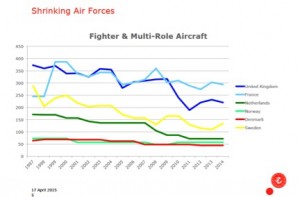
But what is not widely realized that the RAF has been able to put a template for transformation together, which can allow it to play an effective joint and coalition role.
At the heart of the RAF approach is necking down from a larger type model series of aircraft to a smaller set of multi-mission aircraft which can provide for a more effective integrated role.
The sustainable reach part of the RAF is seeing the introduction of the new A330MRTT tanker, and the introduction of the A400M along with the C-17.
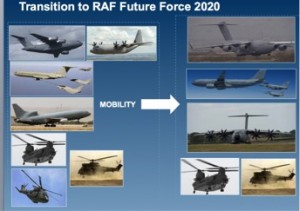
In terms of fighter aircraft, the RAF is undergoing a double transition with the Typhoon via weaponization and combat system upgrades taking on the Tornado roles along with the introduction of the F-35B aboard the new carrier.
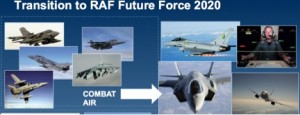
This means that not only are the dynamics of different generations of aircraft – Typhoon with F-35 — to drive change but from the outset the RAF is working new approaches for the integration of sea-based and land-based air in a variety of new scalable, modular combinations under the influence of innovative C2 solution sets.
And they will be doing this with among others, the USMC, which is of course focused on pathways to do much the same thing as the RAF envisages with the introduction of the F-35B into the RAF.
Group Captain Godfrey highlighted throughout his presentation that the capabilities of the F-35 to work with other coalition F-35s via the “global fleet” of fifth generation aircraft was a significant enhancer of the combat effectiveness of the RAF itself.
Clearly, the aperture of collaboration is opening up for the RAF to work with Air Forces like the Norwegian and the Dutch who will fly F-35s as their core combat aircraft.
And already, these F-35 partners are broadening discussions with one another about how to deliver collaborative convergent combat capabilities in key areas of strategic interest.
Prior to the F-35, the Norwegians and the Dutch flew F-16s which the RAF did not, which limited the level of collaboration among these Air Forces. Now the F-35 as a platform as well as a way to rethink and redesign combat innovations is a catalyst for change, to use Group Captain Godfrey’s phrase.
And with the Italian Air Force as well as the RAF working the double transition of modernized Tyhoons along with the introduction of F-35s (in the case of the IAF this includes both F-35As and F-35Bs along with the Italian Navy F-35Bs aboard their carriers as well), the RAF can work effectively with a core European ally in shaping new approaches to integrated air operations as well.
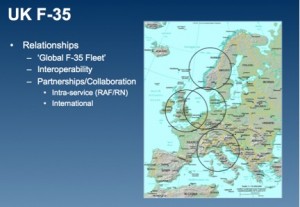
An important theme of his presentation was that it was crucial for the RAF to prepare for the F-35 from the standpoint of recognizing its strategic impact, rather than simply thinking of it as a replacement aircraft. The RAF did NOT do this with regard to the Eurofighter, which has delayed the ability of the RAF to get maximum utility from the introduction of that aircraft.
Part of the problem was the lack of certainty about the numbers of the aircraft and their introduction into service, but with the 1998 Strategic Defence Review, there was a clear commitment to Eurofighter numbers and to the new missiles as well, Brimstone, Storm Shadow and Meteor.
Godfrey emphasized that the Eurofighter entered the fleet as a fourth generation aircraft with a third generation operational mentality and this meant that it was not really appreciated in terms of the scope of its new capabilities
“There was no visionary approach to the Typhoon entering service which meant that only an incremental approach was taken, rather than thinking through what significant changes could drive the evolution of the airfleet from leveraging the new aircraft.”
Godrey argued that this did not need to happen with the coming of the F-35.
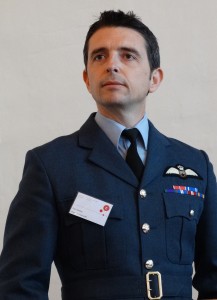
In part this can be driven by the convergence of training and operating the new aircraft three years prior to the aircraft becoming operational aboard the new carrier
“We can use these three years, to prepare the ship for the aircraft, and the aircraft for enabling new approaches as well to operations.”
An important area where the F-35 was a catalyst for change is in the rethinking of training, and training not just for the F-35 but for the Typhoon as well as the rest of the operational fleet.
Notably, there was an expansion of simulation and synthetic training as well as expanding the battlespace within which training would take place.
Over time, live virtual constructive training would be put in place correlated with the impacts and effects of the F-35, but, of course, this would affect the entire fleet and its training and operations.
Group Captain Godrey concluded his presentation this way:
Although we’re flying the airplane along with the US Marine Corp, and they are declaring their initial operating capability this year, in the UK we’re not doing so for another three years.
This allows us to look at how we transform the way that we’re going to do things, notably with the new carrier.
However you characterize fifth gen, the F-35 definitely requires a different approach to realize its benefits. And the F35 definitely has been the catalyst for change in the UK.

